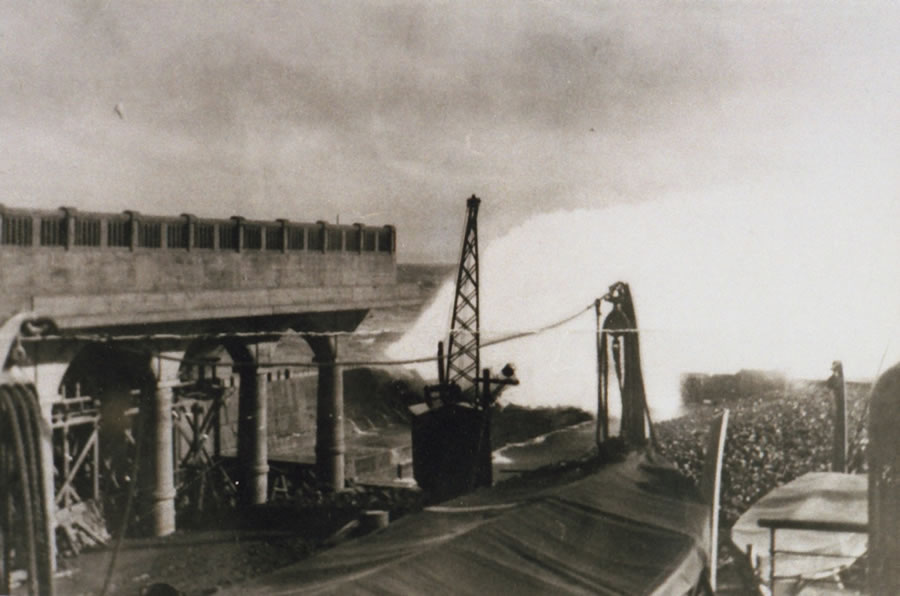What’s the civil engineering heritage?
Does your city or region have civil engineering heritage? They may be a big bridge, dam, bund, tunnel, and any construction or architecture that have a significant impact on the development of local industry and have supported people’s daily life. In Japan, JSCE (Japan Society of Civil Engineering) have conducted an award program for such important architectures. Several architectures are selected annually, through nomination and public solicitation.
51 Civil engineering heritages tell the history of Hokkaido
Hokkaido has 51 heritages, of the approximately 400 in Japan. The breakdown is as follows: 21 inland waterways management facilities (dam and river bank protection), 10 bridge, 5 railwoads and roads, 4 landscapes, 10 seawalls, and 1 coal mine. All of these structures are recognized for their importance in Hokkaido’s pioneering history, and have supported or are still supporting the livelihood of 5.3 million people today. You can see the list of civil engineering heritage in Hokkaido on JSCE’s website (only Japanese)

Asahi Bridge – A symbol of Asahikawa and one of Japan’s most famous large balustrade tied arch bridges (Photo credit: Asahikawa city)
The northernmost civil engineering heritage in Japan
There is an unique heritage in the northenmost port in Hokkaido, namely the northernmost in Japan, Wakkanai north port. The heritage is called “North breakwater dome” because of its function. As shown in the top image, it has half-arched structure and corridor, which is designed to prevent strong wind and high waves when passengers embark to the vessel. Completed in 1936, it had been played an extremely important role because the port is northernmost gateway between Japan and Russia at that time. After WWâ…¡, once regular ferry between Japan adn Russia had restarted from 1995, the port served as a shelter for passengers again. Although the port is no longer plays this role, it is still a outstanding sightseeing spot that eloquently tells the history of Wakkanai.
What to see in Wakkanai: impression of north breakwater dome
I went there last summer 2022. The dome is located near Wakkanai station. Free parking lot is available. The dome appears just across the intersection from the town. You will be surprised at how beautifully it exist in the very peaceful seaside landscape. A picture is worth a thousand words. Please see the video below.
Innovative design by a young engineer who was newly employed
How was this dome constructed? It was designed by Tsuchiya, an engineer who was at that time 26 years old. He had an older colleague whom he looked up to as a mentor, Hitano. The two met at the Wakkanai Port Construction Office for the first time.
When the constructon plan was launched, Hirao ordered Tuchiya to observe sea wave and survey wooden piles of existing one. They found that high waves were easily overcoming the 7-meter-high walls and the wooden piles were terribly damaged by sea water. These facts led Hirao to decide to install a canopy over the breakwater and to use concrete piles.
Hirao ordered Tsuchiya to design a new one, showing a freehand drawing of the shape of dome. At the time, no one in Japan had ever built a breakwater with a canopy, making Tsuchiya completely at a loss. However, he dedicated himself in designing that, taking advantage of his majoy of concrete arch-bridge and some handouts on Greek Roman architecture from his university days.

The breakwater under construction (Photo credit: http://wakkanai-brand.jp/chiikishigen/c01_kitabouhateidome.html)
Although Thuchiya said he have cried over the formwork design as well, his extraordinary ability can be seen in the streamlined design of the arch beams that gradually buried in the wall surface. The interesting fact is that Tsuchiya did not know that a breakwater with canopy was rare in the world. He also did not know how much his design was appreciated because Hirao did not give him any praise. Thus, the dome was created through the collaboration of two engineers.

To tell you the truth, the dome was not a famous from the beginning. In 1964, after 28 years from completion, it got widely reported in newspapers and gradually appeared in tourist guidebooks. Later, in 1976, the dome had been deteriorated due to sea salt, and was to be torn down. However, thanks to the enthusiastic efforts of citizens, it was determined to be faithfully restored, which made the dome remain as it is today.
Infrastructure with excellent design can be the symbol of local community
In this way, the infrastructure with excellent design can gradually influence the regional identity and provide a valuable tourist resource. This is an valuable history of civil engineering heritage that not only satisfies its function, but also serves as an expression of the local culture.


Nami

